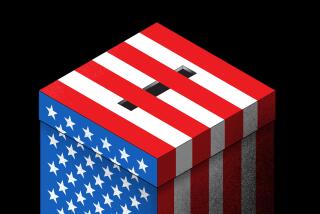Supreme Court Rejects Uneven Welfare Benefits
The Supreme Court Monday struck down California’s bid to pay lower welfare benefits to newcomers, ruling that the Constitution requires states to give the same rights to all residents.
In an unusually strong opinion, the justices said that states may not try to fence out poor people nor may they discriminate against them once they have arrived.
“Citizens of the United States, whether rich or poor, have the right to choose to be citizens of the state wherein they reside,” wrote Justice John Paul Stevens for a 7-2 majority. “The states, however, do not have any right to select their citizens.”
At issue was whether state officials could try to end the attraction of California as a “welfare magnet” by limiting for one year benefits for new residents to their former states’ payment levels. In that way, for example, a family of four on welfare from Mississippi would receive that state’s monthly rate of $144 rather than California’s rate of $673.
The plan, sponsored by former Gov. Pete Wilson in 1992, never went into effect but officials believed that it would have saved the state between $11 million and $16 million a year. California spent $2.9 billion in 1996, the last year for which statistics are available, to support those on welfare. Its benefit levels are the nation’s sixth highest.
Gov. Gray Davis, in a statement issued by his press secretary, said that the governor is “disappointed with the ruling” because the two-tiered payment system did not violate the constitutional right of welfare recipients to move to a new state.
But the court ruled that a mother in need of welfare has a “right to be treated equally in her new state of residence” and not forced to live on the lower benefits paid where she used to live.
The Supreme Court decision does not affect the sweeping welfare reforms enacted by Congress three years ago that have helped push a generation of recipients off welfare rolls and onto payrolls.
The federal welfare reform law did, however, allow states to experiment with two-tiered systems of welfare payments and 14 states followed California’s lead in enacting such systems. A federal judge in Sacramento and the U.S. court of appeals in San Francisco blocked the two-tiered benefits plan from taking effect in California and the Supreme Court struck down all such state laws in its action Monday.
Eloise Anderson, Wilson’s director of social services, said that the decision was disappointing but not surprising, since lower courts had consistently held the provision unconstitutional.
“I think the states ought to have a right to determine who they give benefits to and who they don’t,” she said. “But as long as the federal government puts money in the pot that is going to be a problem.”
Anderson, who is now director of the American family program at the Claremont Institute, a conservative think tank, said that welfare reform and its requirements that recipients go to work have made the issue less important to conservatives than it once was.
“Everybody has to work now,” she said. “It was an issue in the late 1980s and early 1990s when welfare was out of control and . . . you had governors saying, ‘Let me put a stop to this anyway I can.’ ”
The case decided Monday grew out of a lawsuit brought by the ACLU of Southern California against the state’s director of social services, now Rita Saenz, on behalf of two women who moved to the Los Angeles area in 1997. One, dubbed “Brenda Roe,” was pregnant when she moved from Oklahoma to Long Beach. Because of complications from the pregnancy, she could not work immediately.
Had the law taken effect, her benefits would have been limited to the $307 per month paid in Oklahoma, rather than the $565 paid in California. Living costs are much higher in California than in the Southern and rural states, the lawsuit noted, and this explains much of the disparity in payments. The suit also pointed out that the state could save the same $10 million per year by lowering benefits for everyone by 72 cents per month.
Mark D. Rosenbaum, the ACLU’s legal director who argued the case, praised the court for “reaffirming the principle that states may not fence out poor migrants.”
The outcome “will be especially welcomed by mothers and their children fleeing domestic violence who may now settle in California secure that they will not be denied necessary assistance,” he said.
This is not the first time in the court’s history that it threw out a California law targeting poor newcomers.
During the Great Depression, the state made it a misdemeanor to “bring into the state any indigent person who is not a resident of the state, knowing him to be an indigent person.” Fred Edwards of Marysville was convicted under this law in 1940 and sentenced to six months in jail for bringing his wife’s brother from Texas.
When the case reached the Supreme Court in 1941, the state law was defended by then-California Atty. Gen. Earl Warren. But in a 9-0 decision, in Edwards vs. California, the justices threw out the law and said that Americans had “a fundamental right to move freely from state to state.”
In 1969, the court under then-Chief Justice Earl Warren struck down state laws that gave newcomers no welfare benefits for a year. Five years later, a liberal majority also threw out a Phoenix-area ordinance that prohibited newcomers who were poor from obtaining free, nonemergency care for one year in local hospitals.
But dissenting conservative justices complained that the case was ill-founded, because limiting welfare benefits does not tread on the constitutional “right to travel.”
In Monday’s opinion, Stevens went back to the post-Civil War era and used a right that has been ignored for most of the last 130 years.
To assure that newly freed slaves would not be discriminated against in the South, the Reconstruction Congress enacted the 14th Amendment and declared all persons to be “citizens of the United States” who “shall be entitled to all privileges and immunities of citizens” in every state. Stevens said that this means all citizens of the state, including new residents, “have the same rights as others who share their citizenship.”
This historical analysis appears to have won over several of the court’s conservatives, such as Justice Antonin Scalia and Anthony M. Kennedy.
And some constitutional scholars think that this legal reasoning could prove as important as the decision in favor of welfare recipients.
Harvard Law Professor Laurence H. Tribe said that Monday’s opinion “is truly a landmark opinion” for revitalizing a basic principle in the U.S. Constitution.
“This turns out to be terribly important, not so much as a welfare case, but as a decision about the structure of the union and what it means to be a citizen,” Tribe said.
Out-of-state college students and traveling hunters and fishermen need not rejoice, however.
The court’s opinion speaks of “true residents” of the state, as were the welfare parents in this case. States may continue to charge higher tuition to out-of-state students or out-of-state fishermen seeking licenses because they are not true residents.
Dissenting in the case (Saenz vs. Roe, 98-97) were Chief Justice William H. Rehnquist and Justice Clarence Thomas.
Times staff writer Virginia Ellis contributed to this story from Sacramento.
* REDISTRICTING: The Supreme Court also gave states some leeway to redraw electoral districts. A16
(BEGIN TEXT OF INFOBOX / INFOGRAPHIC)
Where the Ruling Applies
The Supreme Court’s welfare ruling was a blow to California and more than a dozen other states that have tried to limit payments to newcomers:
Note: North Carolina allowed the
welfare limits on a county by county
basis.
Source: National Governors’ Assn., Times wire reports; compiled by JANET LUNDBLAD/ Los Angeles Times
More to Read
Get the L.A. Times Politics newsletter
Deeply reported insights into legislation, politics and policy from Sacramento, Washington and beyond. In your inbox three times per week.
You may occasionally receive promotional content from the Los Angeles Times.







